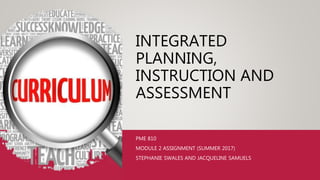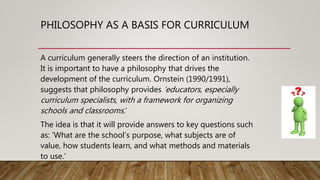Concepts, philosophies design of curriculum
- 1. INTEGRATED PLANNING, INSTRUCTION AND ASSESSMENT PME 810 MODULE 2 ASSIGNMENT (SUMMER 2017) STEPHANIE SWALES AND JACQUELINE SAMUELS
- 3. DEFINITIONS Concepts • The means and materials with which students will interact for the purpose of achieving identified educational outcomes Philosophies • Provides a framework and guidelines for organizing curriculum and program development Design • The arrangement of curriculum, connecting all the parts and showing how they interrelate
- 4. PHILOSOPHY AS A BASIS FOR CURRICULUM A curriculum generally steers the direction of an institution. It is important to have a philosophy that drives the development of the curriculum. Ornstein (1990/1991), suggests that philosophy provides ‘educators, especially curriculum specialists, with a framework for organizing schools and classrooms.’ The idea is that it will provide answers to key questions such as: ‘What are the school’s purpose, what subjects are of value, how students learn, and what methods and materials to use.’
- 5. MAKING CONNECTIONS Concept: Academic Rationalism Philosophical Base: Perennialism, Realism Design: Subject, Discipline Curriculum Focus: Subjects, mastery of facts and knowledge
- 6. ACADEMIC RATIONALISM Perennialism/Realism • Focus on classical disciplines/subjects • Goal for intellectual excellence Subject Design, Discipline Design • Focus is on subject matter, the disciplines • Stresses understanding conceptual processes of a discipline
- 7. MAKING CONNECTIONS Concept: Cognitive Process Philosophical Base: Pragmatism Design: Broad Fields, Learner Centred Curriculum Focus: ethods of how We educate, Development of transferable cognitive skills
- 8. COGNITIVE PROCESS Pragmatism • Role of educator is to facilitate learning progression • Best actions/processes to develop cognition in educational and social settings Broad Field, Learner Centered Design • Connections are made between concepts within different disciplines • Emphasis on the learners and how they learn
- 9. MAKING CONNECTIONS Social Reconstruction Philosophical Base: Pragmaticism, Design: Problem Centered, Romantic/Radical Curriculum Focus: societal needs, education for societal change
- 10. SOCIAL RECONSTRUCTION Pragmaticism • Education to improve society • Identify and solve societal problems Problem Centered, Romantic Radical Design • Focused on injustice within society • Belief that change is required to better humanity
- 11. MAKING CONNECTIONS Concept: Self Actualization Philosophical Base: Idealism, Pragmatism Design: Process, Learner Centred Curriculum Focus: Education enables learners for the future
- 12. SELF ACTUALIZATION Idealism, Pragmatism • Emphasis on intellectual growth of learner • Goal is to develop psychologically and sociologically Process, Learner Centered Design: • Aim to teach transferable cognitive skills • Learning is outgrowth of individual experience
- 13. MAKING CONNECTIONS Concept: Technological Process Philosophical Base: Realism Design: Subject Curriculum Focus: Efficiency in teaching methods by which knowledge is shared
- 14. TECHNOLOGICAL PROCESS Realism • Concerned with tangible learning results • Emphasis on the most efficient method to impart knowledge Subject Design • Content is organized • Focus predominantly on content over individual
- 15. REFERENCES • Edward S., Ebert. C., Bentley M., Defining Curriculum (updated Jul 19, 2013), Retrieved from https://www.education.com/reference/article/curriculum-definition/, July 10, 2017 • Eisner, E.W. &Vallance, E. (1974). Conflicting Conceptions of Curriculum. Berkeley, CA: McCutchan Publishing Corporation • Ornstein, A. C. (1990/1991). Philosophy as a basis for curriculum decisions. The High School Journal, 74, 102-109. • Hill, A. M. (1994). Perspectives on philosophical shifts in vocational education: From realism to pragmatism and reconstructionism. Journal of Vocational and Technical Education, 10(2), 37-45.















